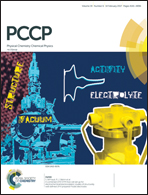A novel crystallization pathway for SiGe alloy rapid cooling†
Abstract
Understanding the structural evolution of covalent systems under rapid cooling is very important to establish a comprehensive solidification theory. Herein, we conducted molecular dynamics simulations to investigate the crystallization of silicon–germanium (SiGe) alloys. It was found that during crystallization, the saturation and orientation of covalent bonds are satisfied in order, resulting in three phase transitions. The saturation is satisfied during a continuous phase transition that occurs in the super-cooled liquid state. When the orientation was satisfied at the local scale, a novel state, the critical-nuclei crystalline (CNC) phase was obtained, where the local diamond structures increase in number with time and ultimately stabilize at an average size at the critical value. Finally with a coordinated rearrangement of atoms, the orientation is satisfied globally and a stable diamond crystal is produced. For SiGe alloys this CNC phase is universal and rather stable, and the stable temperature range has a certain relationship with the cooling rate and number fraction of atoms. This novel pathway is believed to be universal for such materials including carbon. The CNC state can explain the observation that diamond can be obtained without high pressure. These findings will significantly advance the understanding of the mechanism of phase transition, particularly for covalently bonded materials.



 Please wait while we load your content...
Please wait while we load your content...